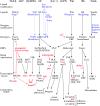Conditional switches for extracellular matrix patterning in Drosophila melanogaster
- PMID: 18245854
- PMCID: PMC2278091
- DOI: 10.1534/genetics.106.065912
Conditional switches for extracellular matrix patterning in Drosophila melanogaster
Abstract
An F(1) mutagenesis strategy was developed to identify conditional mutations affecting extracellular matrix (ECM) patterning. Tubulogenesis requires coordinated movement of epithelial cells and deposition of a multilayered ECM. In the Drosophila ovary, an epithelium of follicle cells creates the eggshells, including the paired tubular dorsal appendages (DAs) that act as breathing tubes for the embryo. A P-element mutagenesis strategy allowed for conditional overexpression of hundreds of genes in follicle cells. Conditional phenotypes were scored at the level of individual mutant (F(1)) female flies. ECM pattern regulators were readily identified including MAPK signaling gene ets domain lacking (fused DAs), Wnt pathway genes frizzled 3 and osa (long DAs), Hh pathway gene debra (branched DAs), and transcription factor genes sima/HIF-1alpha, ush, lilli, Tfb1, broad, and foxo. In moving cells the [Ca(2+)]/calcineurin pathway can regulate adhesion to ECM while adherens junctions link cells together. Accordingly, thin eggshell and DA phenotypes were identified for the calcineurin regulator calreticulin and the adherens junction component arc. Finally a tubulogenesis defect phenotype was identified for the gene pterodactyl, homologous to the mammalian serine/threonine receptor-associated protein (STRAP) that integrates the TGF-beta and PI3K/AKT signaling pathways. Because phenotypes can be scored in each mutant fly before and after gene induction, this F(1) conditional mutagenesis strategy should allow for increased scale in screens for mutations affecting repeated (reiterated) events in adult animals, including gametogenesis, movement, behavior, and learning.
Figures








References
-
- Araujo, H., E. Negreiros and E. Bier, 2003. Integrins modulate Sog activity in the Drosophila wing. Development 130 3851–3864. - PubMed
-
- Berg, C. A., 2005. The Drosophila shell game: patterning genes and morphological change. Trends Genet. 21 346–355. - PubMed
-
- Bieschke, E. T., J. C. Wheeler and J. Tower, 1998. Doxycycline-induced transgene expression during Drosophila development and aging. Mol. Gen. Genet. 258 571–579. - PubMed
Publication types
MeSH terms
Substances
Grants and funding
LinkOut - more resources
Full Text Sources
Molecular Biology Databases
Research Materials
Miscellaneous

